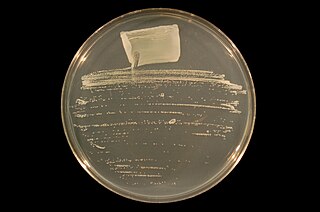
The Burkholderiaceae are a family of bacteria included in the order Burkholderiales. It includes some pathogenic species, such as Burkholderia mallei (glanders) and Burkholderia pseudomallei (melioidosis).

Halomonadaceae is a family of halophilic Pseudomonadota.
In taxonomy, Ruegeria is a genus of the Rhodobacteraceae. This genus was formerly known as the marine Agrobacterium before they were reclassified in 1998. It bears in fact the name of Hans-Jürgen Rüger, a German microbiologist, for his contribution to the taxonomy of marine species of Agrobacterium.

Ensifer is a genus of nitrogen-fixing bacteria (rhizobia), three of which have been sequenced.

Cronobacter is a genus of Gram-negative, facultatively anaerobic, oxidase-negative, catalase-positive, rod-shaped bacteria of the family Enterobacteriaceae. Several Cronobacter species are desiccation resistant and persistent in dry products such as powdered infant formula. They are generally motile, reduce nitrate, use citrate, hydrolyze esculin and arginine, and are positive for L-ornithine decarboxylation. Acid is produced from D-glucose, D-sucrose, D-raffinose, D-melibiose, D-cellobiose, D-mannitol, D-mannose, L-rhamnose, L-arabinose, D-trehalose, galacturonate and D-maltose. Cronobacter spp. are also generally positive for acetoin production and negative for the methyl red test, indicating 2,3-butanediol rather than mixed acid fermentation. The type species of the genus Cronobacter is Cronobacter sakazakii comb. nov.
The Chloroflexota are a phylum of bacteria containing isolates with a diversity of phenotypes, including members that are aerobic thermophiles, which use oxygen and grow well in high temperatures; anoxygenic phototrophs, which use light for photosynthesis ; and anaerobic halorespirers, which uses halogenated organics as electron acceptors.
Thermoanaerobacter is a genus in the phylum Bacillota (Bacteria). Members of this genus are thermophilic and anaerobic, several of them were previously described as Clostridium species and members of the now obsolete genera Acetogenium and Thermobacteroides
Gracilibacillus is a genus of bacteria within the phylum Bacillota. Species within this genus are generally halotolerant.
Virgibacillus is a genus of Gram-positive, rod-shaped (bacillus) bacteria and a member of the phylum Bacillota. Virgibacillus species can be obligate aerobes, or facultative anaerobes and catalase enzyme positive. Under stressful environmental conditions, the bacteria can produce oval or ellipsoidal endospores in terminal, or sometimes subterminal, swollen sporangia. The genus was recently reclassified from the genus Bacillus in 1998 following an analysis of the species V. pantothenticus. Subsequently, a number of new species have been discovered or reclassified as Virgibacillus species.
Bacteriovorax is a genus containing a single species of bacterium in the family Bacteriovoracaceae, Bacteriovorax stolpii. It is a predator that feeds on larger Gram-negative bacteria. These prey bacteria tend to live in enteric environments and have similar lipopolysaccharide structures. Bacteriovorax stolpii recognizes its prey by outer membrane protein receptors, which explains why Gram-positive bacteria that lack outer membranes do not serve as prey. They prey on bacteria by invading the interperiplasmic space where they feed, grow, and reproduce. Bacteriovorax stolpii used to be classified in the genus Bdellovibrio because of similar morphologies and lifestyle characteristics, however they were recognized as a new genus through phylogenetic analysis.
Prosthecomicrobium is a genus of aerobic bacteria which was isolated from freshwater samples.
Prosthecomicrobium pneumaticum is an aerobic bacterium from the genus of Prosthecomicrobium which has been isolated from freshwater.
Devosia confluentis is a Gram-negative and aerobic bacteria from the genus of Devosia which has been isolated from the Sea of Japan on Korea.
Devosia enhydra is a bacterium from the genus of Devosia.
Devosia mishustinii is a bacterium from the genus of Devosia.
Neptunomonas is an anaerobic and rod-shaped genus from the family of Oceanospirillaceae.
Kaistiaceae is a family of Alphaproteobacteria.
Alkalihalobacillus is a genus of gram-positive or gram-variable rod-shaped bacteria in the family Bacillaceae from the order Bacillales. The type species of this genus is Alkalihalobacillus alcalophilus.
Peribacillus is a genus of rod-shaped bacteria that exhibits Gram-positive or Gram-variable staining that belongs in the family Bacillaceae within the order Bacillales. The type species for this genus is Peribacillus simplex.
Alkalicoccus is a genus of Gram-Positive rod-shaped bacteria in the family Bacillaceae from the order Bacillales. The type species of this genus is Alkalicoccus saliphilus.



